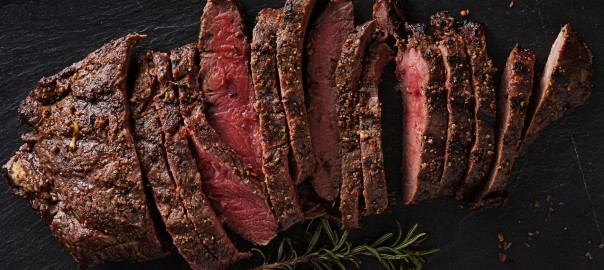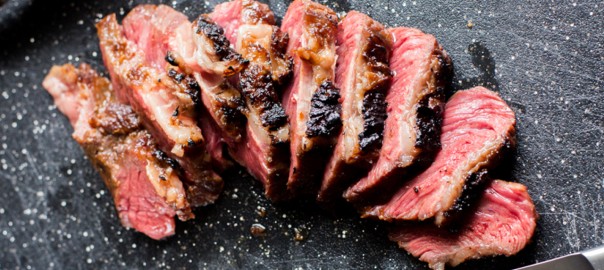Flat iron steak shouldn’t work. It is named after a domestic appliance, it is notoriously hard to find outside of restaurants, and it comes from an area of the cow, the shoulder blade, that was long considered too tough to produce any tender, enjoyable steaks.
But if you’ve ever had a grilled flat iron steak from a steakhouse or cooked it in your own backyard, you know that it is an amazing cut of beef.
The history of flat iron steaks
Flat iron steak is a tender cut of beef that not only has an interesting history but is also tough to find, similar to the Denver steak. Flat iron is not as prevalent in the butcher case as rib-eye, filet mignon, or flank steaks, but it is quite popular on restaurant menus in America and beyond.
Flat iron steak, which derives its name from its shape being similar to that of an old-fashioned clothes iron, has been around, in some form, for a while. The cut, or something similar to it, is known as the butler steak in the U.K. or the oyster blade steak in Australia and New Zealand. In some places, it can also be called book steak, petite steak, or shoulder top blade steak. However, much like the Denver steak, the flat iron steak as we now know it was not discovered until 2002 by researchers at the University of Florida and the University of Nebraska, and also as part of the Beef Checkoff Program.
The cut is derived from the shoulder of the cow, specifically from the top blade of the chuck primal cut. For a long period of time, the region from where the flat iron steak is derived was waste meat or used in ground beef mixes. This was due to the connective tissue that ran through it, making it undesirable as a stand-alone cut.
The researchers from Florida and Nebraska found a way to remove the gristle, creating a fibrous, marbled steak that is popular as a bistro steak. The term bistro steak is often used for tasty, tender cuts that are used by smaller restaurants as a delicious, cheaper alternative to more expensive cuts at high-end steakhouses like a New York strip steak.
The popularity of the flat iron steak among chefs is due to the versatility of the flavorful cut. According to our own Chef Yankel Polak, our in-house ButcherBox chef, “The flat iron steak is an industry darling, a new-age steak.”
It’s such a challenge to find in stores because it is in such high demand with restaurants. “It is on every top-notch steak joint’s menu these days,” Chef Yankel says.
Preparing flat iron steak
The tender cut can be cooked as is, but it is often used with a rub or marinade. It’s popular as a stir-fry meat, sometimes sliced for sandwiches, and commonly used with chimichurri or other spicy sauces for tacos. It can also be the centerpiece of other dishes.
The flat iron steak is ideal for grilling because it is relatively easy to cook. Whether using a marinade or just some olive oil, kosher salt, and freshly ground black pepper, our chef says that cooking it medium rare is best to keep the steak tender.
As Chef Yankel also explains, “It has a deep grain, so cutting against the grain is imperative, but it has minimal connective tissue, so your slices don’t have to be super thin.”
Chef Yankel says that flat iron is similar to both skirt steak and hanger steak, “For mouthfeel, it’s slightly chewy but in an enjoyable way, and for meatiness, it tastes like what you imagine beef should taste like,” he explained.
It is a shame that the cut is so prevalent among restaurants, as it is difficult for steak-loving consumers to find on their own. (Luckily, if you are a ButcherBox subscriber, it is often featured in our monthly boxes.)
Because of its great taste and usefulness, the flat iron steak has gained a tremendous reputation in the 15 years since it was discovered. Its legend will likely continue to grow. As Chef Yankel explains, “They will trend to higher price points as they gain popularity.”
So try to get your hands on one soon, or you might be priced out of the flat iron steak market in the near future.
Here is one of our favorite flat iron steak recipes, Chef Yankel’s Pepper-Crusted Flat Iron with Root Vegetable Mash.
Pepper-Crusted Flat Iron with Root Vegetable Mash
Ingredients:
- 2 ButcherBox flat iron steaks
- 2 tablespoons coarse ground black pepper
- 1 tablespoon kosher salt
- 3 medium parsnips, peeled and sliced
- 1 large turnip, peeled and sliced
- 4 cloves garlic, smashed
- 3 cups milk
- 4 tablespoons butter
- 1 tablespoon fresh parsley, chopped
- 1/2 cup Parmesan cheese, grated
Directions:
1. Preheat oven to 350 F. Place cast iron pan in the oven.
2. Place parsnips, turnip, garlic, and milk in small saucepan. Add more milk if needed to cover vegetables.
3. Simmer on low heat until vegetables are tender. Remove vegetables from pot, and place in a bowl.
4. Add butter and mash vegetables, adding small amounts of milk as needed to get a thick mashed consistency
5. Add Parmesan and parsley and scoop mash into medium cupcake tins. Sprinkle top with black pepper and bake for 20 minutes, or until golden brown.
6. Pour coarse black pepper on a plate and press one side of flat iron steaks onto pepper. Season steaks on both sides with kosher salt.
7. Remove cast iron pan from oven, add a small amount of oil and place steaks in pan, pepper side down. Return pan to oven. After 4 minutes, flip steaks. Continue to cook in oven 4 more minutes or until thermometer inserted into thickest part reads 120 F.
8. Let steaks rest at room temperature for at least 8 minutes. Serve with mash and enjoy!







